| Liverpool Town Centre and Museum Area |
|
|||||||
| Liverpool Town Centre and Museum Area |
|
|||||||
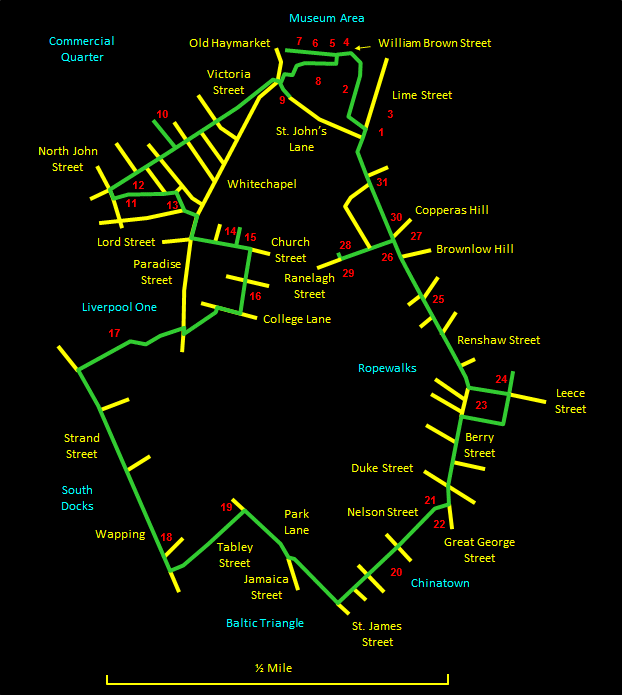 |
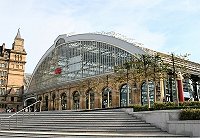 |
The walk as described starts at Lime Street Station [1], but several starting points are possible including Central Station [28] or by car there are car parks on Lime Street, in the Museum Area, at the northern end of Whitechapel, at the South Docks and elsewhere, or you can park on the roadside in the Baltic Triangle. Lime Street Station [1] is a superb iron and glass structure. From the steps of the main entrance, the eye is drawn to the magnificent neoclassical St. Georges Hall [2] opposite, a Grade I Listed building opened in 1854. Cross over Lime Street to the plateau in front of the hall and note the imposing North-Western Hotel building [3] opposite. |  |
 |
||
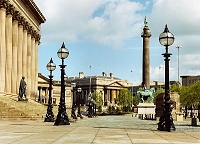 |
The features of St. George's Plateau include four huge lions, equestrian bronzes of Queen Victoria and Prince Albert and dolphin-based cast iron lamp standards; Disraeli stands on the steps to the hall. At the end of the plateau towers Wellington's Column, 132 ft (40 m) high and completed in 1865. Next to it is the cast iron Steble Fountain of 1879; statues of Neptune, Amphitrite, Acis and Galatea sit around the base. Now we are at the top end of William Brown Street. It is difficult to take in the entire sweep of the magnificent neoclassical buildings here in one go. At the top end is the County Sessions House [4], completed in 1884. | 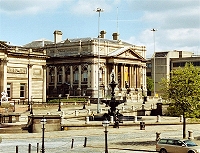 |
||
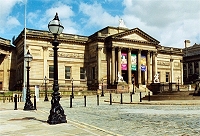 |
Next along William Brown Street is the Walker Art Gallery [5], completed in 1877 and now housing one of the largest art collections in England outside of London - obviously a must-see for the art lover. On the top of the building is an allegorical figure representing Liverpool, holding a traditional trident and a somewhat more progressive ship's propeller. Next is the Central Library Comlex [6], dominated by the Picton Library of 1879 with its stunning circular interior room and dome - viewing recommended. Next door is the William Brown Library of 1860, which shares a building with the Museum. Hidden behind it is the beautiful Edwardian Hornby Library of 1906. A stunning and multiple award-winning upgrade to the interior and facilities was completed in 2013. The jaw-dropping new interior is topped by a roof terrace and café with great views over the city. | 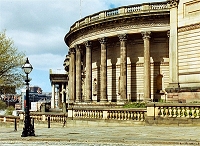 |
 |
|
Finally there is the Museum, completed, with the William Brown Library, in 1860 and the Central Technical School building of 1901, now used by the museum [7]. Now known as the World Museum, the main classes of exhibit are Astronomy, Space and Time, including a planetarium, Archaeology, Egyptology and Ethnology, and Biology, Zoology and Geology. Facing the Central Technical School is the entrance to the first of the two Mersey tunnels, with its Portland stone Art Deco style frontage, officially opened by George V and Queen Mary in 1934, whose statues stand either side. Walk back part of the way up William Brown Street and enter St. John's Gardens [8]. This is a pleasant open space in the city centre with formally laid out borders and a large collection of memorials and statues. | 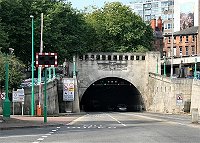 |
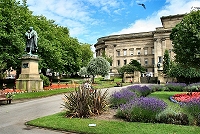 |
||
 |
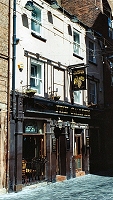 |
Exit the gardens at the bottom end on St. John's Lane and cross over the road making for Victoria Street. If you like, a short detour up St. John's Lane will bring you to Dr. Duncan's [9], an unusual pub with an interior that is well worth seeing. Head along Victoria Street and there is another characterful pub, the tiny old-fashioned Poste House [10], off to the right on Cumberland Street. Turn left into North John Street and immediately left into Matthew Street, a place of pilgrimage for Beatles fans boasting the Cavern Club [11] and a pub, The Grapes [12], much frequented by the Beatles in the early 60s. The maze of narrow streets here is known as the Cavern Quarter. Near the end of Matthew Street, turn right into Rainford Gardens for, yes, another great pub, The White Star [13], with its beautiful rear lounge with shipping memorabilia. Follow Rainford Gardens into Button Street and then turn right into Whitechapel. The latter continues into Paradise Street and together they mark the course of Liverpool's long since dried up river The Pool, emphasised by the rising land along Lord Street and Church Street. Turn left into Church Street, originally Liverpool's main shopping street, and on the left along Tarleton Street is another nice pub, the long, narrow and homely Carnarvon Castle [14]. | 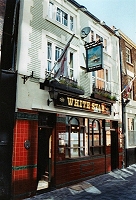 |
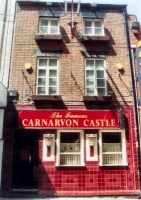 |
||
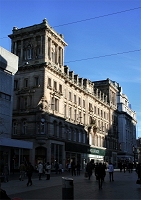 |
A little further along Church Street on the left, the imposing Marks and Spencers store was once Compton House [15]. It opened in 1867 as an exceptionally early purpose-built department store, one of the first in the world. Turn right into Church Alley, where you will see Bluecoat Chambers [16] at the end. This lovely Queen Anne-style building, the oldest surviving building in the centre of the city, was completed in 1725 as a school for teaching poor children to read, write and do accounts. Walk into the courtyard and through the building into the peaceful garden at the back. | 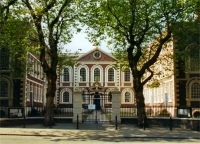 |
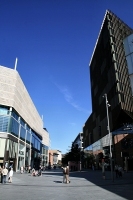 |
Emerge at the back onto College Lane and go right to enter the new shopping, residential and leisure centre of Liverpool, Liverpool One, which was completed in 2009 and is the largest city centre development in Europe since World War II. You might want to have a look around the rather smart shops and there are numerous restaurants on the top level. Branch left along Manestys Lane and cross Paradise Street going to the right of the John Lewis store, then up the steps to Chavasse Park [17], an elevated and very pleasant open space. | 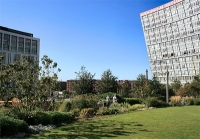 |
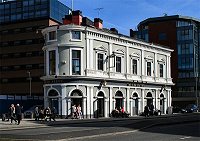 |
Head towards the South Docks and leave the park via the steps to emerge onto Strand Street, where you turn left. Walk along Strand Street for about 500 yards (m) with the docks on your right and the Baltic Triangle on your left to reach the Baltic Fleet [18], an unpretentious enthusiasts' pub with with bare boards and several atmospheric rooms. Just past the pub, follow the curving road to the left into Tabley Street and follow this to the end on Park Lane. On the left here is Gustav Adolfs Kyrka [19], the Swedish seamen's church of 1884 with a typically Scandinavian spire and stepped gables. Turn right along Park Lane bearing slightly left into St. James's Street and after about 350 yards (m) turn left into Nelson Street. |  |
||
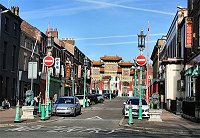 |
 |
Nelson Street is the heart of present-day Chinatown, one of the oldest Chinese communities in Europe. Walk along Nelson Street past Great George Square [20] to find the main section with its plethora of Restaurants. The magnificent Chinese Arch [21], designed and made in Shanghai and erected in 2000, spans the north-eastern entrance to Nelson Street. On the left at the end of Nelson Street is the Great George Street Congregational Chapel building [22], an imposing, neoclassical church of 1841, whose massive pillars are apparently the tallest in the country. | 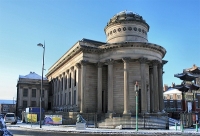 |
 |
Turn left along Great George Street and cross Duke Street into Berry Street. At the far end is St Luke's Church [23] of 1831, a prominent Liverpool landmark and one of its most beautiful churches, though bombed in the May Blitz of 1941. Just before the church turn right into Bold Place and then left along Roscoe Street. Crossing Leece Street brings you to The Roscoe Head [24], a hidden gem of a pub. Traditional, welcoming, vibrant and unspoiled, there are three tiny rooms surrounding the small bar area. | 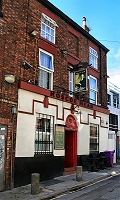 |
 |
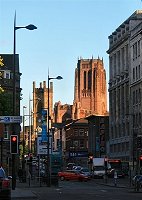 |
Go down Leece Street and turn right into Renshaw Street. Half-way down on the right is the extraordinary Grand Central [25] of 1905, originally the Central Hall of the Liverpool Wesleyan Mission. It incorporates a flamboyant mixture of styles and currently has a variety of uses, including being home to a some unconventional boutiques. Looking back up Renshaw Street, there is a fine view towards St. Luke's Church and the Anglican Cathedral, with the remains of the original 1923 Lewis's Department Store building [26] on the right. The rest was devastated in the blitz of May 1941 and the new store, the largest in the city, opened in 1951. It sports Jacob Epstein's bronze figure on the prow of a ship above the main entrance. Opposite Lewis's is the Adelphi Hotel [27] of 1914, at that time regarded as the most luxurious hotel outside London, its grandeur reflecting the importance of transatlantic travel to Liverpool in the early part of the 20th century. | 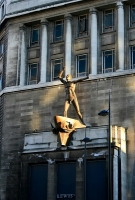 |
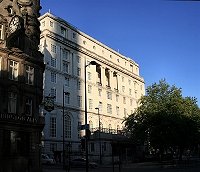 |
||
 |
A short detour down Ranelagh Street followed by a right turn into Cases Street discloses The Globe [28], another fine unspoilt pub, dating from 1888. An unusual and initially unnerving feature is the floor, which slopes upwards considerably towards the rear. Opposite is Central Station [29]. Returning to Lime Street, you can't avoid noticing The Vines [30] of 1907, a Baroque fantasy and one of a number of pubs in the city demonstrating brewer Robert Cain's commitment to flamboyant architecture. The interior is sumptuous with an abundance of carved mahogany, plaster friezes and copper-work. There are several ornate rooms, crowned by the grand lounge at the rear with its large glass dome, wooden panelling, ornate fireplace with mirror and crystal chandeliers. Nearer the station is the Crown Hotel of 1905, whose exterior is immediately striking but hardly prepares you for the magnificence of the two large interior rooms, with elaborate plaster and gold leaf ceilings and wood panelling. It is a short step from here to Lime Street Station and the end of the walk. |  |
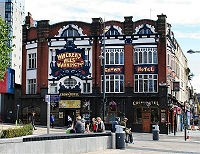 |